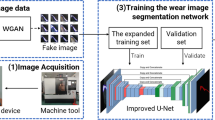Abstract
Measuring and extracting abrasive grains on the entire surface of monolayer brazing grinding wheels to analyze the distribution of abrasive grains are of great significance to grinding research and grinding wheel manufacture. It is not easy to carry out the work with traditional methods. In this paper, a linear CCD is used to acquire the entire grinding wheel surface image, and an improved encoder–decoder network based on Efficientnet, ASPP, and Skip Connections is designed to promote the accuracy and speed of abrasive grains prediction. Based on dataset creation, transfer learning, and hyper-parameter testing, 91.21% abrasive grain semantic segmentation accuracy was finally obtained. If we focus on whether the abrasive grains are recognized without considering semantic errors, an accuracy rate of 99.6% is obtained. The method can provide basic data for grinding mechanism research and abrasive tool manufacturing.











Similar content being viewed by others
References
Xi X et al (2017) High speed grinding of particulate reinforced titanium matrix composites using a monolayer brazed cubic boron nitride wheel. Int J Adv Manuf Technol 90(5):1529–1538
Huang G et al (2018) Grinding characteristics of aluminium alloy 4032 with a brazed diamond wheel. Int J Adv Manuf Technol 95(9):4573–4581
Wang W et al (2022) Simulation and experimental study of the ground surface topography of GH4169 by grains arrayed brazed diamond wheels. Int J Adv Manuf Technol 118(1):303–317
Malkin S, Guo C (2008) Grinding technology: theory and application of machining with abrasives. Industrial Press Inc
Su H et al (2016) Experimental research on performance of monolayer brazed diamond wheel through a new precise dressing method—plate wheel dressing. Int J Adv Manuf Technol 87(9):3249–3259
Aurich JC, Kirsch B (2012) Kinematic simulation of high-performance grinding for analysis of chip parameters of single grains. CIRP J Manuf Sci Technol 5(3):164–174
Zhao Q, Y.G.E.B. (2006) Ultra-Precision Grinding of BK7 Optical Glass Using Coarse-Grinding Electroplated Diamond Wheel. Chin J Mech Eng 42(10):95–101
Qiu Y, Huang H (2019) Research on the fabrication and grinding performance of 3-dimensional controllable abrasive arrangement wheels. Int J Adv Manuf Technol 104(5):1839–1853
He Q et al (2022) Experimental investigation on performance of electroplated CBN wheel with ordered arrangement of abrasives in dry grinding. Int J Adv Manuf Technol 121(7):4919–4927
Darafon A, Warkentin A, Bauer R (2013) Characterization of grinding wheel topography using a white chromatic sensor. Int J Mach Tools Manuf 70:22–31
Yu H, Lu Y, Wang J (2016) Study on wear of the grinding wheel with an abrasive phyllotactic pattern. Wear 358:89–96
Tahvilian AM et al (2015) Characterization of grinding wheel grain topography under different robotic grinding conditions using confocal microscope. Int J Adv Manuf Technol 80(5):1159–1171
Yang T et al (2021) Intelligent manufacturing for the process industry driven by industrial artificial intelligence. Engineering 7(9):1224–1230
Liu J et al (2022) The effect of artificial intelligence on carbon intensity: Evidence from China’s industrial sector. Socioecon Plann Sci 83:101002
Li Z et al (2022) A deep transfer learning method for monitoring the wear of abrasive belts with a small sample dataset. J Manuf Process 74:374–382
Cheng C et al (2019) Deep convolutional neural network-based in-process tool condition monitoring in abrasive belt grinding. Comput Ind 106:1–13
Long J, Shelhamer E, Darrell T (2015) Fully convolutional networks for semantic segmentation. In: Proceedings of the IEEE conference on computer vision and pattern recognition, pp 3431–3440
Ronneberger O, Fischer P, Brox T (2015) U-net: Convolutional networks for biomedical image segmentation. In: Medical Image Computing and Computer-Assisted Intervention–MICCAI 2015: 18th International Conference, Munich, Germany, October 5-9, 2015, Proceedings, Part III 18. Springer International Publishing, pp 234–241
Han J et al (2021) Online estimation of the heat flux during turning using long short-term memory based encoder-decoder. Case Stud Therm Eng 26:101002
Üzen H et al (2022) Swin-MFINet: Swin transformer based multi-feature integration network for detection of pixel-level surface defects. Expert Syst Appl 209:118269
Božič J, Tabernik D, Skočaj D (2021) End-to-end training of a two-stage neural network for defect detection. In: 2020 25th International Conference on Pattern Recognition (ICPR). IEEE, pp 5619–5626
Chen L et al (2017) Deeplab: Semantic image segmentation with deep convolutional nets, atrous convolution, and fully connected crfs. IEEE Trans Pattern Anal Mach Intell 40(4):834–848
Tan M, Le Q (2019) Efficientnet: rethinking model scaling for convolutional neural networks. In: International conference on machine learning. PMLR, pp 6105–6114
Zhao Y, Bi W, Ge P (2021) An on-line inspection method for abrasive distribution uniformity of electroplated diamond wire saw. J Manuf Process 71:290–297
Funding
The authors received support from the Natural Science Foundation of Fujian, China (Grant No. 2021J01855, 2021J05168, 2022H0020); doctoral research fund of Jimei University (Grant No. ZQ2021055); and Jimei University cultivate program of National Nature Science Foundation of China (Grant No. ZP2022013).
Author information
Authors and Affiliations
Contributions
Junying Chen: general scheme, writing the original draft, resources, and funding acquisition. Boxuan Wang: set up measurement system, data curation, writing the original draft. Yiming Lin: programming. Xiuyu Chen: English writing assistance. Qingshan Jiang: system integration guidance. Changcai Cui: conceptualization.
Corresponding author
Ethics declarations
Ethics approval
The article follows the guidelines of the Committee on Publication Ethics (COPE) and involves no studies on human or animal subjects.
Consent to participate
Not applicable.
Consent for publication
Not applicable.
Competing interests
The authors declare no competing interests.
Additional information
Publisher's Note
Springer Nature remains neutral with regard to jurisdictional claims in published maps and institutional affiliations.
Rights and permissions
Springer Nature or its licensor (e.g. a society or other partner) holds exclusive rights to this article under a publishing agreement with the author(s) or other rightsholder(s); author self-archiving of the accepted manuscript version of this article is solely governed by the terms of such publishing agreement and applicable law.
About this article
Cite this article
Chen, J., Wang, B., Lin, Y. et al. Efficient-Unet: Intelligent identification of abrasive grain on the entire surface of monolayer brazing wheel based on encoder–decoder network. Int J Adv Manuf Technol 131, 6027–6037 (2024). https://doi.org/10.1007/s00170-024-13305-4
Received:
Accepted:
Published:
Issue Date:
DOI: https://doi.org/10.1007/s00170-024-13305-4




